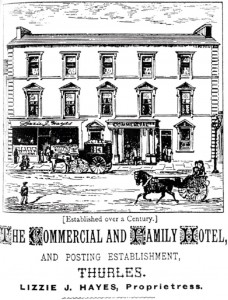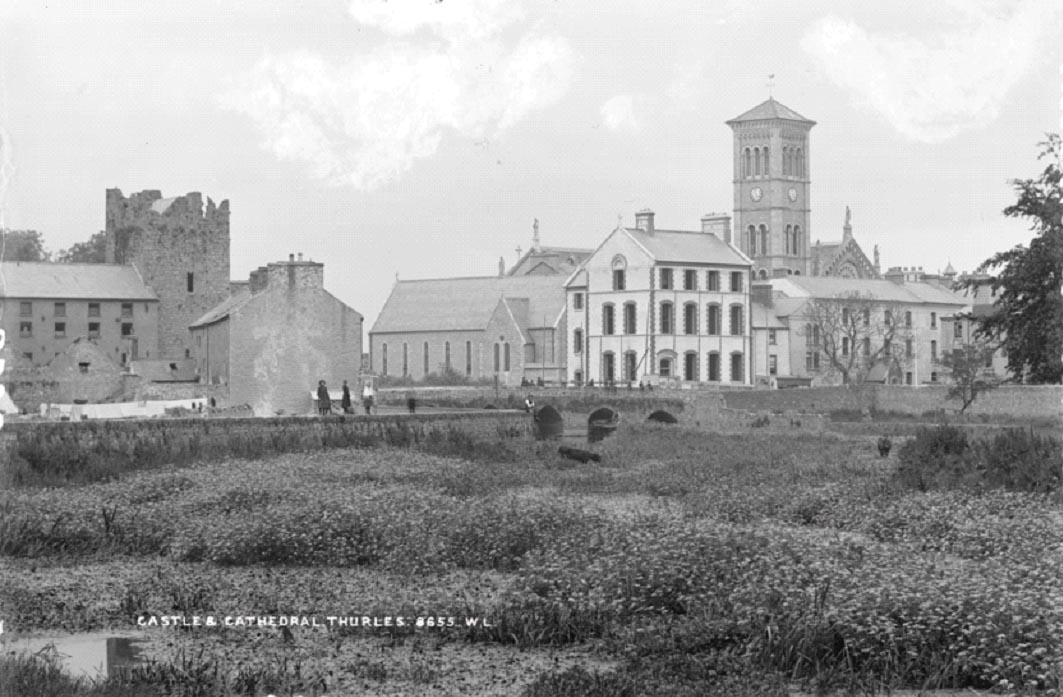Who was present at the founding of the GAA at Thurles in 1884?
Published in 18th-19th Century Social Perspectives, Features, Issue 5 (September/October 2015), Volume 23A SUBJECT OF MUCH DEBATE AMONG HISTORIANS OF IRISH SPORT

Contemporary print of Hayes’s Hotel.
The inaugural meeting of the GAA, on Saturday 1 November 1884, at Lizzie J. Hayes’s Commercial Hotel on Main Street, Thurles, has been the subject of much debate among historians of Irish sport. Apart from the date and venue, they have agreed on little else.
The motivation of those who responded to Michael Cusack and Maurice Davin’s letter of invitation has attracted divergent interpretations. Likewise, the number present has been recorded as between seven and thirteen. In his account of the occasion, as published by United Ireland and The Irishman, Cusack wrote:
‘At a … meeting, which was held in Miss Hayes’s Commercial Hotel, Thurles, last Saturday, a Gaelic association for the preservation and cultivation of national pastimes was formed. The meeting was called by a circular signed by Mr Maurice Davin, Carrick-on-Suir, and Mr Michael Cusack, Dublin. In addition to the gentlemen who called the meeting, there were also present Mr J.W. Power, Leinster Leader, Mr P.J. O’Ryan [sic], solicitor, Callan and Thurles, Mr J. M’Kay, Cork, Mr Bracken, Templemore, Mr St George M’Carthy, Templemore, etc, etc.’

‘A few etceteras’
A generation later, T.F. O’Sullivan maintained that, ‘notwithstanding the fact that Mr Cusack placed a few etceteras after the names of those attending’, only the seven listed above were present. A subsequent assertion, however, by Séamus Ó Riain that O’Sullivan had done considerable research in the files of national and provincial newspapers in the preparation of his history proved to be untenable. Marcus de Búrca argued that ‘by adding the cryptic and infuriating phrase “etc, etc” to his authoritative list of seven’ Cusack ‘gave a false impression that more than that number had attended’. De Búrca also made the inaccurate claim that newspapers hostile to Cusack named twelve people as having attended, whereas supportive organs purportedly gave the figure as seven. As to why Cusack’s rivals would boost his cause by inflating the attendance at Thurles, he offered no explanation.
The Thurles-based Tipperary Leader was certainly not opposed to the Clare man’s aspirations. A contemporary advertisement described the journal as advocating ‘everything calculated to improve the condition of the people, and to work out the objects of the National League’. Advance publicity was provided by the paper for Cusack’s project in its issue of 31 October. The following week’s edition covered the transactions of the inaugural event in considerable detail:
‘On Saturday last a meeting was held in Miss Hayes’s Commercial Hotel, for the purpose of establishing an association to promote … the national pastimes of the country … Amongst those present … were Messrs Michael Cusack, M. Davin, J. Wyse Power (Naas and Kildare Club), J.R. Bracken [sic], Templemore, John M’Kay (Cork Athletic Club), Joseph Ryan, solr, Callan, St George M’Carthy, DI, RIC, Templemore, W. Foley, Carrick-on-Suir, E. Dwyer, Charles Culhane, Wm Delahunty, M. Cantwell, Thurles, and John Butler, Ballyhudda.’
The Tipperary Advocate published a list containing twelve of the above names, although Charles Culhane was described as ‘D.C. Culhane’, which was probably a conflation of ‘E. Dwyer’ and ‘Charles Culhane’ as reported by the Tipperary Leader.
Veracity of the Tipperary Leader’s report
There is compelling evidence for the veracity of the Tipperary Leader’s report of the foundation meeting. Thurles in 1884 was a small and intimate community; the recent census had returned its population at 4,850 people. The town’s news-paper, with a limited circulation, depended on local news for its very survival. Readers were reminded that ‘every miscellaneous item of local news’ was attended to by ‘corres-pondents in every parish’, and that news was ‘also taken verbally at the office from the general public’. If anything newsworthy occurred in Thurles the Leader was sure to have the details, and in this instance it had almost an entire week and a number of sources from whom to verify the facts.
Two of the founders, Charles Culhane and Michael Cantwell, were known to the editor of the Leader, Patrick Gorman, through their involvement in the Thurles Young Men’s Society. Gorman had attended the launch of that society in 1883 and promised that ‘their meetings … would be fully and faithfully reported’ in his newspaper. He also offered ‘magazines and newspapers for their use’. Indeed, some weeks later he gave them permission to conduct all future business on the newspaper’s premises.
If Gorman did not know John Butler of Ballyhudda personally, he certainly knew him professionally. Butler was a regular, and at times provocative, contributor to many Tipperary publications, including the Leader. The Moycarkey man’s corres-pondence invariably included his townland address. This tempts one to speculate that perhaps he had an influence on the local newspaper’s account of the proceedings at Hayes’s Hotel, as his was the only name linked to a precise location.
William Delahunty would have been known to the editor on a personal basis. As recently as 25 September both men had attended a meeting, in the Leader office, to organise funds for William O’Brien MP. Delahunty, a member of a Ballingarry family, had been involved in the commercial life of the town for a considerable time.
‘E. Dwyer’ (recorded by the Freeman’s Journal as Dwyer) was almost certainly a misprint for T.K. Dwyer of Littleton, the one-mile champion of Ireland in 1878. No suitable candidate bearing the former name can be traced from contemporary sources. According to tradition, Dwyer was among those who ass-embled in Lizzie Hayes’s hotel, although when a family member shared this information in the 1930s with Fr Philip Fogarty, the future author of Tipperary’s GAA Story, his contribution was dismissed as spurious.
Presence of a police officer
Even though Séamus Ó Riain and Marcus de Búrca supported T.F. O’Sullivan’s contention that only seven were present at the meeting of 1 November, the results of ongoing research led both men to concede that others were present in the hotel that afternoon. De Búrca suggested that a ‘handful … stayed out of the billiards-room’ because ‘they would not join a group that included a police officer’. It is highly unlikely that T.K. Dwyer, who had served a jail sentence for boycotting during the Land War, and Charles Culhane, afterwards incarcerated in Wormwood Scrubs for Sinn Féin activities, would be intimidated by the presence of a policeman. Moreover, the officer in question, Thomas St George MacCarthy, was not noted for his devotion to duty. William Delahunty, on the other hand, would have been quite at ease in the company of a police officer, as his family’s public house was a rendezvous for both the police and the military. In a subsequent publication de Búrca tentatively put the attendance at thirteen, but, apparently unconvinced, he immediately suggested that ‘possibly only seven were present’.
Ó Riain’s claim, that although ‘the other named six’ came ‘to meet Davin … to express their support for the movement … they did not take part in the meeting in the billiard room’, is implausible. It is simply not credible that one of that six, William Foley of Carrick-on-Suir, who was in all probability Davin’s former rowing colleague, would have travelled to Thurles to wish his friend well in the lobby of a hotel when he could have done so more conveniently in their home town. Equally implausible is that the gregarious and somewhat egotistical John Butler would have missed the opportunity to join such interesting company in their proposed venture. It would appear that both Ó Riain and de Búrca were compromised by their admiration for T.F. O’Sullivan, who had been a distinguished member of the GAA and also its first historian. Ó Riain, a conservative former president of the association, and de Búrca, its latter-day apologist, were reluctant to challenge what had become official dogma.
Other claimed attendees
Various attempts have been made to connect a number of others to the inaugural event. The principal figures in this group include Henry Joseph Meagher of Tullaroan, Co. Kilkenny, Frank R. Maloney of Nenagh and the Clonoulty native Hugh Ryan. The assertion that Meagher had ‘attended the founding meetings’ [sic], accompanied by his neighbours Ned Tehan and Jack Hoyne, can be safely discounted. Apart from the lack of any supporting evidence, it should be noted that Tehan and Hoyne, who won senior All-Ireland hurling medals with Kilkenny in the championship of 1905, were born c. 1874 and c. 1883 respectively! Both W.F. Mandle’s and Marcus de Búrca’s contention that Frank R. Maloney was in attendance has been ably refuted in Nancy Murphy’s biographical essay on the alleged founder.
The case for Hugh Ryan, a Thurles shopkeeper, is again unsubstantiated. He is reputed to have been at the second meeting of the organisation in Cork and was ‘therefore a delegate from the foundation meeting’. This line of reasoning fails to explain why many others in attendance on that second occasion did not require delegate status to gain entry to the Victoria Hotel venue. A recent historian of Thurles Sarsfield’s GAA Club has attempted to endorse this argument by invoking the Cork Examiner’s inaccurate report of the first meeting which referred to ‘Mr O’Ryan (Thurles)’ and ‘Mr Ryan, solr, Callan’. The unreliable nature of the Examiner’s version is emphasised by the omission of Thomas St George MacCarthy’s name from its list of seven. Hugh Ryan’s family name was never recorded with a prefix in local newspapers, official documents or, indeed, by the man himself. On the other hand, Joseph O’Ryan’s surname was usually reported at that time with a prefix. John McKay, who supplied the Examiner’s account, was clearly unaware that O’Ryan had a practice in both Callan and Thurles. In fact, only a fortnight previously O’Ryan had presented a case at the Thurles quarter sessions. There can be little doubt that ‘Mr O’Ryan (Thurles)’ and ‘Mr Ryan, solr, Callan’ were merely confused references to one Joseph O’Ryan, solicitor of Callan and Thurles.
We leave the final word on the subject to Cusack, who on reflection, when the details were still clear in his memory, declared that the association had been founded ‘by about a dozen Irishmen’.
J.M. Tobin is a Thurles-based sports historian. His research interests include athletics and pre-codified hurling.
Those present
Michael Cusack
Maurice Davin
John Wyse Power
John McKay
J.K. Bracken
Thomas St George MacCarthy
Joseph O’Ryan
William Foley
T.K. Dwyer
Charles Culhane
Michael Cantwell
William Delahunty
John Butler
Further reading
M. de Búrca, Michael Cusack and the GAA (Dublin, 1989).
M. de Búrca, The GAA: a history (Dublin, 1999).
S. Ó Riain, Maurice Davin (1842–1927): first president of the GAA (Dublin, 1994).
T.F. O’Sullivan, Story of the GAA (Dublin, 1916).
















